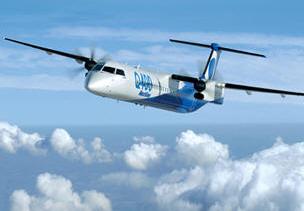|
|||||||||||||||||
|
|
|
|||
|
Bombardier Regional
Aircraft Surpass Fuel Economy Estimates By Jim Douglas |
||||
 |
May 30, 2011 - Bombardier Aerospace confirmed that the
CRJ1000 NextGen regional jet and Q400 turboprop airliner
are both achieving better than expected fuel burn,
rewarding operators with additional cost savings. The CRJ1000 NextGen aircraft is achieving a mission fuel consumption rate that is 4 per cent better than estimated. The additional savings in fuel burn results in an average annual savings of approximately $220,000 US per aircraft.
The improved fuel burn also directly results in a four
per cent reduction in carbon dioxide emissions,
equivalent to an average reduction of nearly 700 tons of
greenhouse gases per aircraft, each year. |
|||
|
?The
CRJ1000 NextGen aircraft is delighting launch customers Air
Nostrum and Brit Air by delivering beyond expectations and
proving to be a sound investment,? said Gary R. Scott,
President, Bombardier Commercial Aircraft. ?The CRJ1000 NextGen
aircraft truly achieves the lowest cash operating cost per mile
for operators in its market segment, while delivering extra
range, exceptional reliability and a greener footprint.?
The
CRJ1000 NextGen aircraft is also achieving six per cent greater
range than previously advertised, providing additional
operational flexibility.
Brit Air
has ordered 14 CRJ1000 NextGen aircraft, while Air Nostrum has
ordered 35. Introduced specifically to meet the needs of growing
regional airlines for jets with up to 100 seats, the CRJ1000
NextGen regional jet offers superior economics, low operating
costs and proven cabin comfort. The aircraft is the optimized
solution in the regional airline industry for medium-haul route
applications, particularly for the replacement of
older-generation single-aisle aircraft in thin markets.
For
operators of the Q400 turboprop, there is also good news;
Bombardier is on target to deliver up to 1.5 per cent in
additional fuel burn improvements, along with the two per cent
improvement already achieved during high-speed cruise. The
better fuel economy comes at no additional expense to operators. |
||||
|
?The Q400
turboprop continues to deliver the best overall operating economics in
its market segment, and Bombardier is providing continuous improvements
to the aircraft?s product offering, including a new business-class
configuration, enhanced navigation systems and a drop-down oxygen system
to further extend the operational capabilities of the aircraft,? added
Mr. Scott.
To give operators
more flexibility, Bombardier confirmed today that it is offering a new
dual-class configuration for the Q400 NextGen aircraft. Later this year,
Bombardier will deliver the first Q400 NextGen aircraft with a
business-class section, featuring three-abreast seating for premium
service and comfort. The launch customer for the new cabin offering will
be announced at a later date. This new dual-class cabin configuration
will also be available as a retrofit for in-service aircraft.
Bombardier
completed the development of an optional drop-down oxygen system for the
Q400 NextGen aircraft in December 2010 to further extend the operational
capabilities of the aircraft. The system can provide up to 22 minutes of
emergency oxygen and has been ordered by customers that fly over
mountain ranges for extended periods of time.
To support greater
efficiency in the use of airspace and allow for shorter routings,
additional fuel efficiencies, better obstacle clearance and avoidance of
noise-sensitive areas, Bombardier is on track to complete its
performance-based Required Navigation Performance (RNP APCH) program for
the Q400 NextGen aircraft later this year. The RNP APCH capability will
be provided as an optional feature and is in accordance with the ICAO
performance-based navigation (PBN) manual. Updated capability statements
will be provided in the Aircraft Flight Manual (AFM).
In addition,
together with launch-customer Japan Air Commuter, Bombardier has
developed a Space-Based Augmentation System (SBAS) option for the Q400
NextGen aircraft. SBAS, also referred to as Wide Area Augmentation
System (WAAS) in North America, provides greater navigation
capabilities, less reliance on ground-based navigation aids and the
potential for more efficient air routes, resulting in both time and fuel
cost savings. |
|
|
| ?AvStop
Online Magazine
Contact
Us
Return To News
|
|

